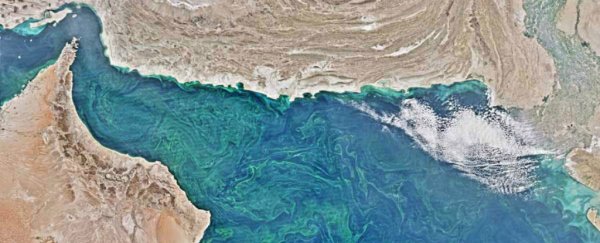The Gulf of Oman plays host to the largest and thickest "dead zone" in the world, but scientists have struggled to study it intensively due to piracy and geopolitical tensions in the region.
Now, thanks to an alleviation in regional conflict, scientists have finally been able to use remote-controlled submarines to reveal the full extent of the area's dead zone.
The data has revealed that this particular dead zone is about the size of the US state of Florida, and it's still growing.
Dead zones, or Oxygen Minimum Zones (OMZs), are areas largely devoid of oxygen, and in the ocean, they are naturally occurring between 200 and 800 meters deep.
The new research has confirmed that the largest OMZ in the world is located in the Gulf of Oman – which is actually a strait, bordered by Iran, Pakistan, Oman, and the UAE – encompassing almost the entire 165,000 square kilometres (63,700 square miles) that make up the ocean region.
But this isn't all the study found.
Using two submarines in combination with computer simulations, scientists have revealed that since the 1990s, the gulf's dead zone has experienced a "dramatic increase" in both size and severity.
According to the recent data, the dead zone is now made up of entirely anoxic or suboxic conditions, which is when no oxygen or very low oxygen is present, respectively.
"Our research shows that the situation is actually worse than feared. The area of dead zone is vast and growing. The ocean is suffocating," lead researcher Bastien Queste said in a statement.
"All fish, marine plants, and other animals need oxygen, so they can't survive there. It's a real environmental problem, with dire consequences for humans, too, who rely on the oceans for food and employment."
The growing OMZ also spells bad news for climate change.
When oxygen is absent, the chemical cycling of nitrogen changes dramatically. This means that in OMZs, the underlying nitrogen cycle is altered so that it produces more nitrous oxide – a greenhouse gas that is roughly 300 times more potent than carbon dioxide.
The problem is made even worse by the fact that the growth of OMZs is strongly linked to climate change. The researchers predict that as the oceans grow warmer, their capacity to hold oxygen will slowly decrease, and these dead zones will continue to spread.
"There are a number of things that could have contributed to the shift—the most major of which is very much tied to climate change," said Queste, a marine biogeochemist from the University of East Anglia's School of Environmental Sciences.
"The oxygen levels are determined by the balance of oxygen supply from the atmosphere, mixed in by waves, eddies, and just general energetic mixing near the surface, and oxygen loss, primarily the oxygen being 'breathed' by bacteria living on and eating sinking decomposing organic matter."
The situation will only be exacerbated by fertiliser and sewage running off the land and into the seas.
"Increase in land use, larger cities, and increased pollution will also lead to more nutrients, such as nitrogen and phosphorus, entering the water, which promotes more algae that later sink and get consumed by the bacteria," said Queste.
"It's an incredibly intricate system with many moving parts," he added.
Using computer simulations of ocean oxygen, the study predicts a decrease in oxygen over the next century and growing OMZs around the world.
The next step for Queste and his team is to figure out whether this is due to the overall supply of oxygen decreasing, or an increased consumption of oxygen in the region.
"Another interesting question is now that the Gulf of Oman is clearly consuming oxygen faster than it is replenished, how much of that is exported to the Arabian Sea and making the wider Arabian Sea OMZ extend and grow even more?" he asked.
The study has been published in Geophysical Research Letters.
